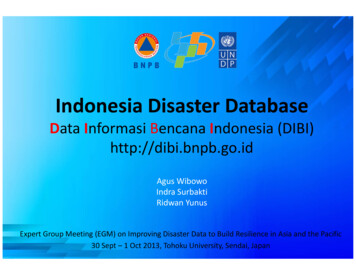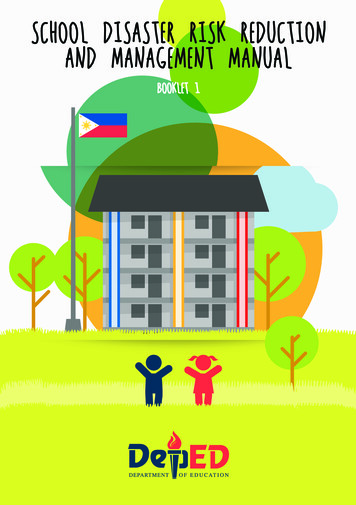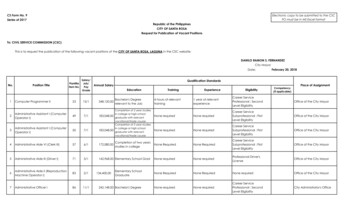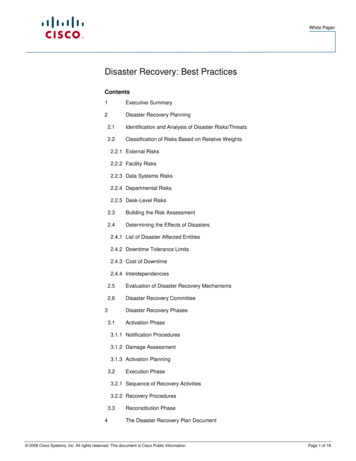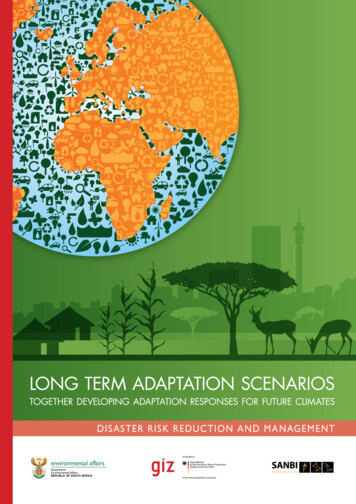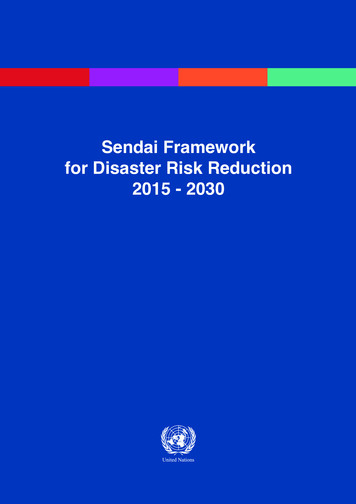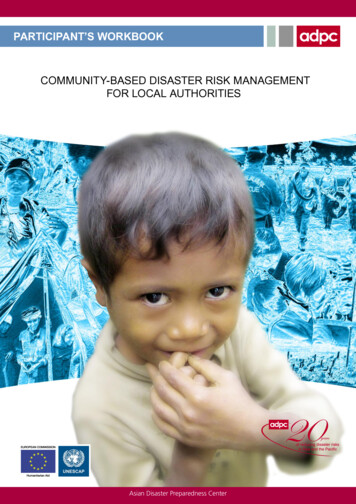
Transcription
PARTICIPANT’S WORKBOOKCOMMUNITY-BASED DISASTER RISK MANAGEMENTFOR LOCAL AUTHORITIESAsian Disaster Preparedness Center
The Partnerships for Disaster Reduction - South East Asia Phase3 (PDRSEA3) program is jointly implemented by (ADPC) and theUNESCAP with funding support from the European CommissionHumanitarian Aid Department (ECHO) under its ‘Fourth DIPECHOAction Plan for Southeast Asia’. The one-year project, which commencedin February 2005, aims to establish an improved, enabling environmentfor CBDRM through promoting ownership in national programs andlocal entities, enhancing the capabilities of CBDRM practitioners andthe expansion of new and strengthening of existing partnerships inSoutheast Asia particularly in the target countries Cambodia, Indonesia,Lao PDR, Timor Léste and Vietnam.The Asian Disaster Preparedness Center (ADPC), established in 1986is a regional, inter-governmental, non-profit organization and resourcecenter based in Bangkok. ADPC is Thailand mandated to promote safercommunities and sustainable development through the reduction of theimpact of disasters in response to the needs of countries and communitiesin Asia and the Pacific by raising awareness, helping to establish andstrengthen sustainable institutional mechanisms, enhancing knowledgeand skills, and facilitating the exchange of information, experience andexpertise.Asian Disaster Preparedness Center (ADPC)P.O. Box 4, Klong Luang, Pathumthani 12120, ThailandTel.: (66-2) 516-5900 to 5910Fax: (66-2) 524-5360E-mail: mailto:adpc@adpc.netWebsite: www.adpc.netUnited Nations Economic and Social Commission for Asia and Pacificis the regional arm of the United Nations Secretariat for the Asian andPacific regions, located in Bangkok, Thailand. UNESCAP is committedto materialize the visions of the United Nations Millennium Declaration,which was adopted by the UN General Assembly in September 2000.The current PDR-SEA project is being implemented jointly by UNESCAPand ADPC at the regional level.For more information, please contact:UNESCAPUnited Nations Building, Rajadamnern Nok Avenue, Bangkok 10200,ThailandTel.: (66-2) 288-1450Fax: (66-2) 288-1059Website: http://www.unescap.org/The European Commission Humanitarian Aid Department (ECHO)oversees and coordinates the European Union’s humanitarian operationsin non-member countries, in partnership with non-governmentalorganizations, specialized agencies of the United Nations, and otherinternational bodies. DIPECHO is the Disaster Preparedness programset up by ECHO in 1996 to prevent and prepare for natural disasters.For more information, please contact:European Commission Humanitarian Aid Office200 rue de la loi B-1049 Brussels, BelgiumTel.: (32 2) 295 4400Fax: (32 3) 295 4572E-mail: echobangkok@ECHO-Bangkok.org
PARTICIPANT’S WORKBOOKCOMMUNITY-BASED DISASTER RISK MANAGEMENTFOR LOCAL AUTHORITIESSHESH KANTA KAFLE AND ZUBAIR MURSHED
CBDRM for Local Authorities: PARTICIPANT’S WORKBOOKPARTICIPANT’S WORKBOOKCommunity-based DisasterAuthoritiesRiskManagmentforLocalPublished by the Asian Disaster Preparedness Center throughits Partnerships for Disaster Reduction - Southeast Asia Phase 3(PDRSEA3) Project jointly implemented by ADPC and UNESCAP withfunding support from DIPECHO ADPC 2006Bangkok, ThailandAuthors: Shesh Kanta Kafle and Zubair MurshedDesign and Layout: Lowil fred EspadaFor more information on this publication and to order a copy, write to:Vicky Puzon-DiopenesInformation ManagerPartnerships for Disaster Reduction - Southeast Asia (PDRSEA)Asian Disaster Preparedness CenterPO Box 4, Klong Luang, Pathumthani 12120, ThailandTel: 66 2 516 5900 to 10, Ext 408Fax: 66 2 524 5360Cell: 66 7 052 4216Email: vicky@adpc.netURL: www.adpc.net
preface20 years of commitment to safer communities andsustainable development through disaster reductionThe Asian Disaster Preparedness Center celebrates its 20 year anniversary in 2006. I wouldlike to take this opportunity to express my sincere appreciation to all its partner institutions,national governments, numerous UN organizations and other international organizations for theircollaboration and support to ADPC during the past two decades. The work of all stakeholders indisaster management, including ADPC staff and alumni have contributed to making communitiesand countries better prepared, safer, and more resilient in face of disasters. ADPC is proud tohave been a pioneer in some of the significant changes-in paradigm, concepts, and practicespaving the way to reduction of the impacts of natural disasters.ADPC was established in 1986 under late Colonel Brian Ward’s illustrious leadership to addressthe disaster management needs of countries in Asia. In its twenty years ADPC respondeddynamically to the paradigm shift in disaster management, readily and actively adjusting itsoperational strengths to address the evolving developments in disaster risk management bystructuring its technical focus on climate risk management, disaster management systems, urbandisaster risk management and public health in emergencies. This vigorous and comprehensiveapproach is further reinforced by ensuring that ADPC’s projects and programs enhance institutionalcapacities, apply community-based disaster risk management practices, and promote andsupport mainstreaming of disaster management into the development processes. These activitiescomplement ADPC’s involvement in building national and provincial disaster management systems,identifying disaster risk management needs, and developing strategic solutions. ADPC’s standingand twenty years of experience in the region is confirmed by the substantive encouragement andsupport from various multi-lateral and bi-lateral development and donor agencies; as manifestediin the implementation of our extensive array of projects and programs.
CBDRM for Local Authorities: PARTICIPANT’S WORKBOOKAs it moves forward beyond its twenty years of operations, ADPC will continue to build upon itsoperational and technical strengths and to evolve in its role as a regional resource center, andto act as a regional early warning center. ADPC will further pursue operational partnerships andcollaborations with all stakeholders in disaster risk management into sustainable developmentpolicies and practices throughout the Asia and Pacific regions.In closing, permit me to express my gratitude to our staff and consultants who have sharedcommitment, dedication and loyalty to ADPC’s goals and mission.As its Executive Director, it is my honor to be part of this fine organization. I am confident thatADPC will continue to be responsive to the priorities of our key stakeholders in governments andthe international community overcoming challenges to serve the region and beyond.iiMessage From Dr. Suvit YodmaniExecutive Director, Asian Disaster Preparedness Center
contentscontentsiPrefaceiiiContentsvList of FiguresvList of TablesviAcknowledgment01Introductionmodule one.INTRODUCTION AND OVERVIEW OF KEY CONCEPTS06Session 1Disaster Risks in Local Area10Session 2Basic Concepts16Session 3Community-based Disaster Risk Management:Rationale and Process24Session 4Overview of the Local Authorities29Session 5Role of Local Authorities in Community-based DisasterRisk Management34Session 6National Disaster Management System46Session 1Community Risk Assessment58Session 2Assessment of Disaster Risk Communication Needs62Session 3Damage, Loss and Needs Assessment70Session 4Community Risk Assessment Toolsiiimodule two.COMMUNITY BASED RISK, NEEDS AND DAMAGE ASSESSMENT
CBDRM for Local Authorities: PARTICIPANT’S WORKBOOKmodule three.COMMUNITY DISASTER REDUCTION PLANNING88Session 1Community Disaster Reduction Planningmodule four.COMMUNITY-MANAGED IMPLEMENTATION92Session 1Community Organizing98Session 2Community Training102Session 3Community Disaster Information Center106Session 4Disaster Risk Communication by Local Authorities110Session 5Early Warning by Local Authorities116Session 6Community Disaster Reduction Fund120Session 7Role of Local Authorities in Community-based HazardMitigation124Session 8Mitigation of Hydro-meteorological Hazards138Session 9Mitigation of Geological Hazardsivmodule five.MONITORING AND EVALUATION152Session 1Monitoring and Evaluation156REFERENCES
contentslist of figures18Figure 1Disaster risk reduction process35Figure 2NCDM structure37Figure 3Institutional structure of BAKORNAS PBP40Figure 4Organizational Structure of Disaster Management Organization in Timor Léste47Figure 5Risk assessment process48Figure 6Concept of risk49Figure 7A view of community hazard mapping in Lao PDR52Figure 8Community resource mapping55Figure 9A risk map using GIS. Risk maps can be prepared manually at local level103Figure 10An example of disaster risk management plan (See Kafle, 2005; Kafle and Koirala,2004)113Figure 11Flood early warning system117Figure 12Sources of funding for community-owned disaster fund19Table 1Community Identification Matrix26Table 2Areas of Analysis for Local Authorities38Table 3CBDRM Projects Implemented by Government or Non-government Agencies39Table 4Status of Hazards in Timor Léste41Table 5Key Hazards of Vietnam50Table 6Hazards Matrix51Table 7An Example of Vulnerability Assessment52Table 8Status of Preparedness Apparatus and Human Resource53Table 9Evaluation of Resources54Table 10Risk Analysis Matrix54Table 11Risk Assembly by VDCs in Nepal (Kafle, 2005)56Table 12Risk Treatment Key59Table 13Data Collection Methods for Assessment of Community’s Risk CommunicationNeeds88Table 14An example of disaster risk management plan (See Kafle, 2005; Kafle and Koirala,2004)vlist of tables
CBDRM for Local Authorities: PARTICIPANT’S WORKBOOKacknowledgmentWe are grateful to the following individuals who attended the Curriculum Development Workshoporganized by the Asian Disaster Preparedness Center (ADPC) on 28-30 November 2005 inBangkok, Thailand; and provided invaluable comments and suggestions to the original draft ofthis participant’s workbook.Khun Sokha (NCDM, Cambodia), Ken Vaddanak (CRC, Cambodia), Noel Puno (CARE,Cambodia), Syahabani Hamid (BAKORNAS PBP, Indonesia), Banu Subagyo (OXFAM GB,Indonesia), Chandra Lukitasari (IIDP, Indonesia), Sengkham Kompackkdy (NDMO, Lao PDR),Keo Chanthalangsy (World Vision, Lao PDR), Lino de Araujo (NDMO, Timor Léste), Joao Perriera(CARE, Timor Léste), Nguyen Thu Ha (VRC, Vietnam), Dang Quang Minh (CCFSC, Vietnam),Tran Tu Anh (NRC, Vietnam), Nguyen Van Bang (CARE, Vietnam), Le Quang Duat (Action AidInternational, Vietnam), and Emily de Vera (ADPC). In addition, suggestions given by Arghya(ADPC) and Vidiarina (CARE, Indonesia) are highly appreciated.viThe curriculum development workshop was facilitated by Ms. Zenaida Delica-Willison, of theUNDP South-South Cooperation; and Ms. Mayforth Luneta, from Center for Disaster Preparedness(Philippines), based upon the feedback from the workshop. The curriculum was revised by Kafleand Zubair.
introductionintroductionPurpose and ScopeThe purpose of this workbook is to facilitate the capacity building of local government officials onCommunity-based Disaster Risk Management (CBDRM) in PDRSEA target countries includingCambodia, Indonesia, Lao PDR, Timor Léste and Vietnam. It is expected that the workbook will beadapted and used by National Disaster Management Offices (NDMO) and NGOs in the countriesof South East Asia for training the local government officials.Target UsersThe workbook is primarily intended for those who will train the lowest government politicalstructure and those who will facilitate the implementation of CBDRM at the communities; e.g.district authorities giving training to village authorities. They can also be: NDMOsTrainers at district, provincial and commune levelsProvincial government officialsDistrict government officialsNGOs/CBOsLine MinistriesInternational organizations; e.g. IFRC, National SocietiesThe primary beneficiaries of this workbook will be the local government officials who will do CBDRMactivities. Secondary beneficiaries will include NGOs and other non-government organizations.This workbook is for the participants during a training course, and is not a manual of operations.MethodologyThe following steps were adopted while preparing the workbook:Review of existing training manuals and curricula in the regionDiscussion amongst ADPC staff members about the contents of the workbookRegional workshop on curriculum development for local authoritiesRevision on the basis of feedback from the Regional workshop1
CBDRM for Local Authorities: PARTICIPANT’S WORKBOOKTraining ModulesThere are altogether 5 training modules and 20 training sessions in this workbook. The followingtopics have been covered:Module 1: Introduction and Overview of Key ConceptsModule 2: Community Risk, Needs and Damage AssessmentModule 3: Disaster Risk Reduction PlanningModule 4: Community Managed ImplementationModule 5: Participatory Monitoring and EvaluationEach module is structured as:1.2.3.4.Learning objectives of the sessionKey conceptsReference materials: content of the sessionReferencesTraining Methods2This workbook can be used for both in-house training with field exercises and self-study. At theend of each session, note page for ‘New Learning and Reflection’ have been included.
introductionReference materialsThe following publications were extensively consulted while preparing this handbook:- ADPC, CBDRM-11 Course Materials, 2003.- Abarquez, Imelda. and Zubair Murshed, Community-based Disaster Risk Management: FieldPractitioners’ Handbook, ADPC, 2005- Kafle, Shesh Kanta. and Govinda, Koirala, Chitwan District: Disaster Management Action Plan,UNDP/UNOCHA/DDC Chitwan. Nepal, 2004- Disaster Preparedness Manual, Vietnam Red Cross Society, September 2000.- UNDP/CECI, Trainers’ Guide on CBDRM, CECI Vietnam- Sustainable Community-based Disaster Management Practices In Asia, A User’s Guide,UNCRD, Kobe, Japan, December 20043- Citizenry-based Development Oriented Disaster Management in the Philippines, CDP, Manila
module oneModule ObjectivesAt the end of the Module, you should be able to: Discuss the key hazards, vulnerabilities and capacities atthe local level Describe the administrative, political, social and economicstructure of the area Explain the rationale and process of community-baseddisaster risk management Define the key terms and concepts like hazard, vulnerability,capacity, risk, disaster, disaster risk reduction Describe the role of local authorities in Community-basedDisaster Risk Management Discuss the Disaster Risk Management System in yourcountryNo of Sessions1. Disaster risks in the local area (district, municipality orcommune)2. Basic concepts3. CBDRM: Rationale and process4. Overview of the local authorities5. Role of local authorities in CBDRM6. National Disaster Risk Management System
INTRODUCTION AND OVERVIEWOF KEY CONCEPTS
1CBDRM for Local Authorities: PARTICIPANT’S WORKBOOKsession 1disaster risk in the local areaLearning ObjectivesAt the end of this session, the participants should be able to: Enlist the major disasters that occurred in your district, municipality or communeover the past 10 years; Describe the impact of such disasters upon the life, livelihoods, economy andenvironment in the locality; Define the most vulnerable social groups in the local area, and describe the reasonsfor their vulnerability; Discuss the local resources and capacities to cope with and recover from thedisasters; Enumerate challenges faced and lessons learnt by different stakeholders;Key Concepts A local area might be exposed to a number of disaster risks. It will be necessary tounderstand the nature, and impact of these disasters in order to better prepare forfuture; A range of social groups may exist in a district, municipality or commune. Thevulnerability of different groups may differ from each other. It is important for localauthorities to understand the reasons for vulnerability of different groups; The communities, local authorities and civil society groups may have multipleresources and capacities to deal with disasters; e.g. indigenous knowledge, policies,disaster reduction programs, technical institutions, machinery and equipment, andsocial networks; Local authorities must identify the challenges faced and lessons learnt from thepast experiences of responding to disasters;Reference Materials6Disaster Risks in the Local Area
session 1. disaster risks in local areaIntroductionThis session intends to discuss the status of hazards, vulnerabilities and historical overview ofdisaster occurrences in the district, municipality or commune. The session will be organized in adiscussion manner. A district, municipality or commune might be exposed to a range of natural orman-made hazards. The communities, their livelihoods, local economy and infrastructure and theenvironment might be exposed to multiple risks from such hazards. Natural hazards may includetyphoons, floods, droughts, fires (forest and urban fires), avalanches, earthquakes, tsunamis andlandslides. Man-made hazards include social conflicts, industrial and chemical hazards, road andair accidents, nuclear accidents, environmental pollution etc. Different hazards have diverse impactupon the people, their livelihoods, environment and economy and infrastructure. It is important tounderstand the kind of impact a hazard can have upon the communities in the locality.A review of the past disasters would allow the local authorities to identify the vulnerable locationsand communities. The local authorities can gather information about the past disasters from varioussources; e.g. government relief records, local newspapers, research reports in the universitiesand technical institutions, reports of the relevant government bodies; e.g. the meteorologicaldepartment, or volcanology department. The analysis of the impact of past disasters on variouscommunities and social groups will help understand the relationship between the nature of hazardand the kind of impact they can have upon various at-risk-elements. Through this analysis thelocal authorities can also identify the high impact hazards; e.g. those which kill the most people,or those which affect severely the local economy and infrastructure.The population in a district, municipality, commune or village may be comprised upon multiplesocial groups. The vulnerability of each group to disasters would be different. It is important thelocal authorities have knowledge about various social groups and their vulnerabilities. The peopleliving near the hazard sites might be more vulnerable than the one living far. Social groups whoselivelihoods are located in dangerous areas would also be more vulnerable; e.g. the fishers, seagypsies, terrace farmers etc. It will also be useful to analyze the resources and capacities whichpeople used to cope with and recover from the previous disasters.During this session, the participants and the resource persons can discuss the topics given in thefollowing checklist in order to understand disaster risks in the local area.1. Past Disasters in the Local Area- What disasters were experienced in the area over the past 10 years?- In which parts of the district or municipality the disasters were occurred?- What is the recurrence period of the relevant hazards?- What was the severity of various disasters?- What was the duration of stay of the hazards?- What other hazards might occur in the local area?2. Impact of disasters- Which social groups were severely affected by the various disasters?- What kind of impact, disasters had upon people?- Which social and economic development sectors were severely affected?- What kind of impact, the disasters had upon the development sectors?- What was the impact of disasters upon the environment?73. Most vulnerable communities and groups- Which social groups were severely affected by the disasters?- What were the reasons, which made these groups more vulnerable?
1CBDRM for Local Authorities: PARTICIPANT’S WORKBOOK- What are their sources of livelihoods?- What is their socio-economic status?- What is the percentage of these groups out of the total population size?4. Local level resources and coping mechanisms- What capacities and resources communities used to deal with the disasters and recoverfrom them? (Please consider the knowledge, material and financial resources, technicalresources, social networks and behaviors that helped people cope with the disasters)- Which key stakeholders were involved in disaster response and recovery?- What resources local authorities used to respond to the disasters and organize recovery?(Please consider the resources of local authorities in terms of disaster reduction and responsepolicies, organizational arrangements, technical and research institutions, equipment andmachinery disaster preparedness, and recovery program etc.- What resources the local NGOs and civil society organizations; e.g. women union, youthunion, elderly union deployed to respond to disasters?5. Challenges and lessons learnt- What problems and challenges did the vulnerable groups face, to deal with the disasters?- What problems and challenges did the local authorities, NGOs, mass organizations andother stakeholders face, in responding to the disasters?- What lessons did the above stakeholders learn, in dealing with disasters in an effectivemanner in future?ReferencesMurshed, Z., Bangkok, ADPC, 2006New Learning and Reflections8
session 1. disaster risks in local area9
1CBDRM for Local Authorities: PARTICIPANT’S WORKBOOKsession 2basic conceptsLearning ObjectivesAt the end of this session, the participants should be able to: Explain the basic concepts related to disaster risk management; e.g. disaster,hazard, vulnerability, capacity, disaster risk, disaster risk assessment, disaster riskreduction.Key Concepts A disaster occurs when a hazard impact upon a vulnerable community and causesdamage, casualties and disruption. Vulnerability is a set of prevailing or consequential conditions, which adverselyaffect the community’s ability to prevent, mitigate, prepare for and respond tohazardous events. Capacities are resources, means and strengths, which exist in households andin the community and which enable them to cope with, withstand, prepared for,prevent, mitigate or quickly recover from a disaster. Disaster Risk is the chance of damage and loss as a result of the occurrence of ahazard. Disaster risk reduction includes all activities to minimize the loss of life, property orassets by either mitigating the hazard or reducing the vulnerability of the elementsat risk.Reference Materials10Basic Concepts
session 2. basic concepts1. DisasterDisaster is a serious disruption of the functioning of a community or a society causing widespreadhuman, material, economic or environmental losses, which exceed the ability of the affectedcommunity or society to cope, using its own resources (UNISDR 2004). A disaster happenswhen a hazard impacts upon a vulnerable population and causes damage, casualties anddisruption. An earthquake in an uninhabited desert cannot be considered a disaster, no matterhow strong the intensities produced. An earthquake is only disastrous when it affects people,their property and activities.2. HazardHazard is an event or occurrence that has the potential to cause injuries to life and damageproperty and the environment. Examples of natural hazards are typhoons, tsunamis, earthquakeand volcanic eruption exclusively. Landslides, floods, drought, fires can be described as socionatural hazards since their causes are both natural and man-made. The distinction betweennatural and man-made hazards is becoming harder to define. For example, flooding may beincreased through landfill, drainage or groundwater extraction; storm surge hazard may beworsened by the destruction of mangroves.Human-made hazards are associated with industries or energy generation facilities and includeexplosions, leakage of toxic waste, pollution, dam failures. War or civil strife is also includedin this category. Some hazards can cause secondary hazards; e.g. an earthquake causinglandslides, which dams a river and then causes flooding. A community may be exposed tomultiple hazards as a result of secondary hazards.3. VulnerabilityVulnerability is a set of prevailing or consequential conditions, which adversely affect people’sability to prevent, mitigate, prepare for and respond to hazardous events. These long-termfactors affect a household or community’s ability to absorb losses after disaster and to recoverfrom the damage. Vulnerabilities precede disasters; contribute to their severity, impede disasterresponse, and may continue to exist long after a disaster has stuck.Anderson and Woodrow (1990) categorize vulnerabilities into three areas:- Physical/Material Vulnerability. For example, poor people who have few physical andmaterial resources usually suffer more from disasters than rich people. People who arepoor often live on marginal lands; they don’t have any savings or insurance; they are inpoor health. These factors make them more vulnerable to disasters and mean that theyhave harder time surviving and recovering from a calamity than people who are better offeconomically.11- Social/organizational Vulnerability. People who have been marginalized in social,economic or political terms are vulnerable to suffering from disasters whereas groups, whichare well organized and have high commitment to their members, suffer less during disasters.Weakness in social and organizational areas may also cause disasters. For example, deepdivisions can lead to conflict and war. Conflict over resources due to poverty can also leadto violence. A second area of vulnerability then, is the social and organizational aspect of acommunity.
1CBDRM for Local Authorities: PARTICIPANT’S WORKBOOK- Attitudinal/Motivational Vulnerability. People who have low confidence in their ability toaffect change or who have “lost heart” and feel defeated by events they can not control, areharder hit by disasters than those who have a sense of their ability to bring the changes theydesire. Thus, the third area of vulnerability is the attitudinal and motivational aspect.4. CapacityCapacities are the assets, resources and skills available within a community, society ororganization that can be used to reduce the risks or effects of a disaster. Capacity may includephysical, institutional, social or economic means as well as skilled personal or collective attributessuch as leadership and management. Capacities enable households and communities to copewith, withstand, prepare for, prevent, mitigate, or quickly recover from a disaster. People’scapacity can also be categorized in the same categories as was done with vulnerabilities in theprevious section.Even the weakest in the community has capacities. The people whose houses or crops havebeen destroyed by a typhoon or flood can recover things from their homes and from their farmsthat can be recycled. Sometimes they have food in storage or crops that can be recoveredfrom the fields or farm implements for planting again. Some family members have skills, whichenable them to find employment if they migrate, either temporarily or permanently.In most disasters, people suffer their greatest losses in the physical and material realm.However, even when everything physical is destroyed, people still have their skills andknowledge; they have family and community organization. They have leaders and systems formaking decisions. They have tribal loyalties or church affiliations. They have capacities in thesocial and organizational realm.People also have positive attitudes and strong motivations such as the will to survive, love andconcern for each other, bravery and willingness to help each other. These, too, are importantcapacities and form the basis for development just as much as the physical resources thatpeople have.5. Disaster RiskDisaster Risk is the chance of likelihood of suffering harm and loss as a result of a hazardousevent. It closely depends upon the exposure of something to a hazard. This can be expressedas:Risk Chance (c) x Loss (L)The output of risk analysis is usually an estimation of the risk scenarios6. Elements at RiskA societal element is said to be ‘at risk’ when it is exposed to hazards and is likely to beadversely affected by the impact of those hazards when they occur.12People (their lives and health), household and community structures, facilities and services(houses, access roads, bridges, schools, hospitals, etc.) livelihood and economic activities(jobs, equipment, crops, livestock, etc.) are described as “elements at risk”. In many cases, thenatural environment is also an element at risk.
session 2. basic concepts7. Disaster Risk AssessmentDisaster risk assessment is a participatory process to assess the hazards, vulnerabilities andcapacities of a community. Through hazard assessment, the likelihood of the occurrence, theseverity and duration of various hazards is determined.The vulnerability assessment identifies what elements are at risk and the causes of theirvulnerable conditions. The households and groups that are most exposed to a hazard areidentified. The assessment takes into account the physical, geographical, economic, socialand political factors that make some people vulnerable to the dangers of a given hazard.In the capacity assessment, the community’s resources and coping strategies are identified.The result of the disaster risk assessment is a ranking of the disaster risks of the communityas basis of planning for risk reduction.8. Disaster Risk ReductionThe reduction of disaster risk is the foundation of community-based disaster risk management.Disaster risk reduction includes activities that will minimize disaster-related losses of life, propertyor assets and environment. Such activities are also described as mitigation measures.9. Disaster PreparednessDisaster preparedness covers activities to enhanc
55 Figure 9 A risk map using GIS. Risk maps can be prepared manually at local level 103 Figure 10 An example of disaster risk management plan (See Kafle, 2005; Kafle and Koirala, 2004) 113 Figure 11 Flood early warning system 117 Figure 12 Sources of funding for community-owned disaster fund list of tables 19 Table 1 Community Identification .
